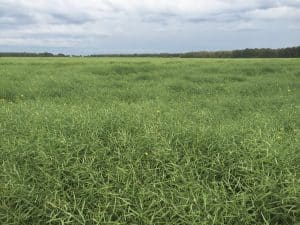You may have made a tentative plan for harvesting your canola a few weeks ago, but conditions may have you considering other options. Here are a few items to note for different situations:
Noticing lodging in your canola?
- Before you make any decisions about harvesting it, get out there and determine why it is lodging. Although it could be due to excess moisture and wind, it could also be due to disease. If this is the case, these plants won’t contribute much to yield anyway, so don’t consider these plants when planning harvest timing and methods.
- When choosing the appropriate harvest method (swathing vs straight cutting) you may want to assess a few factors, including:
- How bad the lodging is: if it is all lodged in one direction, it can be managed easier than if it is lodged in several directions over a greater area.
- Whether if it is a shatter tolerant variety should also be taken into account (and if it is, letting it stand may be the best option for you).
- Which type of equipment you have for straight cutting and if you are prepared to use a dry down aid, if necessary.
- Finally, you may consider how much time you have to work on the crop. If you have more time and the resources (workers), you may want to take the swather into the crop rather than straight cutting to reduce the time and spread out harvest. If you straight cut all your acres and it turns out to be slow-going, will there be an issue getting everything off in a timely fashion? Perhaps a combination of both operations can spread out the workload and ultimate risk.
- Will contact herbicides still be effective in a lodged crop?
- Lodging will make it harder for the herbicide to be effective, but by increasing the water volumes, you can achieve better penetration into the canopy and likely increase your efficacy. Check the labels for water volume recommendation and make sure you are on the high end of the recommendation for best penetration with contact herbicides. Also, higher pressure and smaller droplets will allow for better penetration into the canopy on both lodged crops and crops with a thick canopy. You can also check your provincial Crop Production guides for reference.
- While applying a herbicide (glyphosate) along with a desiccant can appear to save a pass over the field, isn’t necessarily the best time for fall weed control.
- Pre-harvest glyphosate applications are excellent for managing perennial weeds in advance of next year’s crop especially for northern areas and other specific geographies. While post-harvest applications prevent winter annuals, and biennials as well as low growing perennials like dandelion that can cause yield losses before crops are even seeded.
- When choosing to apply any pesticides close to swathing or straight cutting timing, be sure to follow the appropriate Pre-Harvest Intervals (PHIs), conveniently provided to you at spraytoswath.ca
- Had some rain delays before swathing?
- If you are experiencing excess moisture in some fields, it will make it hard to get into the field whether you are swathing or straight cutting. Fully assess the situation before going ahead with a decision and while you are waiting for the field to dry, work on any storage preparations, such as making sure all your fans are running well and your bins are clean and ready for the new crop.
- As it gets later in the season and conditions remain wet, you may want to consider swathing a portion of your fields and straight cutting other to hedge your bets and stagger the timing of harvest operations.
- If it is extremely wet and isn’t drying up, you may decide to try swathing the field just because getting the swather stuck seems more manageable than getting the combine with a straight cut header stuck. This could also allow more sun and air movement for quicker dry-down of the field than if there was standing crop.
- Sticking to your plan of straight cutting could pay off, if the field dries up enough to not get the combine stuck and delaying operations prevents you from swathing too early.
- Adding on the use of a pre-harvest aid prior to straight cutting will help with the plant dry down
- Had some rain while swathing?
- This is not an issue and may even help prevent some shattering of the more mature pods in an uneven stand.
- Want to have better control over the timing of your canola harvest?
- Consider using a pre-harvest aid prior to straight cutting:
- Reglone
- Heat LQ or Heat LQ + glyphosate
- Read more about these options here: https://www.canolawatch.org/2013/08/21/tips-for-pre-harvest-glyphosate-or-reglone/
- Watch the new CCC Harvest management video
- Consider using a pre-harvest aid prior to straight cutting:
For more tips to make straight cutting successful for you, check out:
- https://www.canolawatch.org/2015/08/06/straight-combining-canola-reducing-the-risk/
- https://www.canolawatch.org/2016/08/10/straight-combining-canola-success-factors/
- https://www.canolawatch.org/2013/08/21/top-10-tips-to-lower-straight-combining-risk/
- https://www.canolawatch.org/2014/08/07/best-headers-for-straight-combining-canola/
- http://www.canolacouncil.org/media/545390/CanolaDigest-Sept13/index.html


